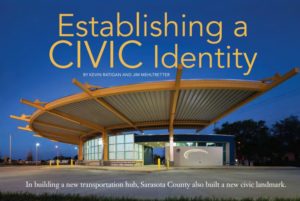 Sarasota County, FL, had long felt the need to consolidate its services into one area. And so, it did, opening a county facilities campus outside the downtown core of the city of Sarasota. The master plan is centered around an “eco-campus” concept where all vehicular traffic is pushed to the outside and the internal campus is focused on reclaiming wetlands and natural vegetation. A prominent feature of the campus is the Bus Transfer Station. Loading and unloading of riders at the station is served by a long, arcing steel canopy that also acts as a gateway to the county campus.
Sarasota County, FL, had long felt the need to consolidate its services into one area. And so, it did, opening a county facilities campus outside the downtown core of the city of Sarasota. The master plan is centered around an “eco-campus” concept where all vehicular traffic is pushed to the outside and the internal campus is focused on reclaiming wetlands and natural vegetation. A prominent feature of the campus is the Bus Transfer Station. Loading and unloading of riders at the station is served by a long, arcing steel canopy that also acts as a gateway to the county campus.
Structural steel was selected for the project because no other material could achieve the form and structural spans required and satisfy the architect’s design requirements while preserving the owner’s budget. Steel also made it possible to economically support the various load requirements, including Florida’s potential for hurricane winds exceeding 150 mph. The new canopy flies over a conventionally constructed steel-framed building that houses restrooms, ticketing offices and a drivers’ lounge. The lounge is situated to allow for clear views of all bus staging areas, using clear and translucent glazing to achieve both privacy and visibility from inside. While the building and canopy are separate, the building serves as a counterweight for the canopy’s foundation.
The site selection and specific configuration of the structure was born out of numerous studies analyzing major route patterns, circulation paths and population growth patterns. The primary goal was to create accessible public transportation hubs and multimodal connectivity to both help the area grow and divert vehicular traffic impacts. The project is part of Sarasota’s effort to breathe new life into its public transportation system by promoting brand identity and ridership through functional structural expression, use of color and open space. The colors for the station were selected from the transit authority’s logo to reinforce the county’s brand identity, and the more vibrant yellow perfectly expresses the radial form of the dynamic steel structure.
The new facility’s layout provides easy bus access, limits crossing points of buses and people and creates a large civic plaza to the south. The design for the canopy demanded a structural solution that could facilitate long spans while minimizing the number of column intrusions, thus creating an open platform with clear views for both pedestrians and bus drivers. The canopy extends 280 ft organized along a structural spine supported by six mast columns and hollow structural section (HSS) supports that cantilever 40 ft out over the driving area.
The six mast columns are hammerhead assemblies with 30-in. wide-flange columns fastened to the foundations using 24 1½-in.-diameter A307 bolts. The hammerhead beams (W30×99) were tapered by removing the bottom flange, then the web was cut, and the bottom flange was shop welded to the web, creating the shape designed by the architect. The bracing members are 6-in.-diameter extra-strong HSS slotted and shop welded to steel knife plates. The top of the hammerhead columns incorporates knife plates designed to accept the stabilization bracing installed at the site. In addition, 10-in.-deep wide flange beams were rolled to 60-ft and 75-ft radii to create the gentle curvature; the HSS was also rolled to the same radii. Pipes were selected as the bracing members because they were capable of resisting tension forces due to gravity loads and compression forces during Florida’s hurricane wind loads.
Originally conceived as a lightweight tensioned fabric assembly intended to reduce the structural mass and allow for diffuse natural light, the canopy roof was ultimately designed as a corrugated metal canopy with a radial ribbing pattern that compliments the overall expression of the structure at a total weight of 130 tons. The result is a more durable structure that casts a dramatic shadow for those riders escaping the intense Florida sunlight. The 7½-in.-wide long-span roof deck is supported by the rolled steel framing and was selected because it could be painted to the architect’s specifications and provide a finished surface on the underside without allowing roofing screws to be visible from below. Research into the dynamics of color application and human perception concluded that the primary yellow results in a slender and elegant profile, while providing immediate identification from vehicles on the adjacent road traveling in excess of 40 mph.
Updated: 2021. Click here to view the original publication.